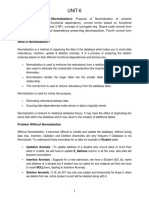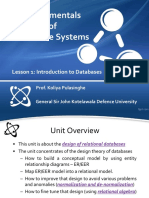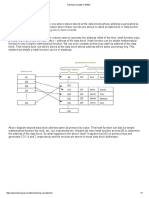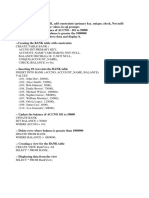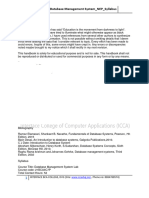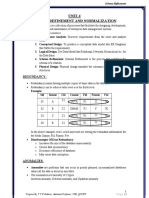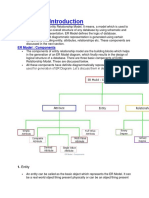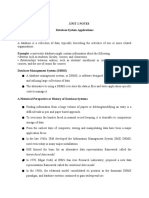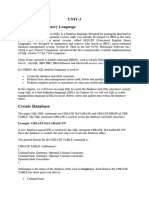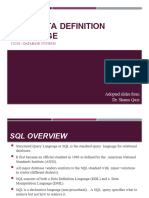0 ratings0% found this document useful (0 votes)
269 views28 pagesDbms III Unit
Uploaded by
Aparna GundeCopyright
© © All Rights Reserved
We take content rights seriously. If you suspect this is your content, claim it here.
Available Formats
Download as PDF or read online on Scribd
0 ratings0% found this document useful (0 votes)
269 views28 pagesDbms III Unit
Uploaded by
Aparna GundeCopyright
© © All Rights Reserved
We take content rights seriously. If you suspect this is your content, claim it here.
Available Formats
Download as PDF or read online on Scribd
You are on page 1/ 28
TT TTT
TT
Aewances SQL: SQL Data Types and Schemas, Integrity Constraints:
vtherksation, Erbeddled SQL, Dynamic SQL, Functions and Procedural
Constructs, Recursive Queries, Advanced SQL Features.
Relational Database Design: Features of Good Relational Desisn, ‘Atomic
Domains and First Normal Form, Functional-Dependency Theory,
Decomposition using Functional Dependencies.
PATE
Apvanceo SQL
3.1.1 Sql Data Types And Schemas
Ql. Explain about SQL data types.
Aus i
SQL data types can be broadly divided into following categories,
(imp.)
1, Numeric data types such as int, tinyint, bigint, float, real etc
Date and Time data types such as Date, Time, Datetime etc.
Character and String data types such as char, varchar, text etc.
nvarchar, ntext etc.
ary etc.
Binary data types such as binary, var
2.
3.
4, Unicode character string data types, for example nchar,
5.
6. es clob, blob, xml, cursor, table ete.
.. Miscellaneous data typ!
ayint, smallint int,
bigint, decimal, numeric, float,
har, Varchar
3 Character/String——* Varehar (max). a
— |” Nehar Nvarcha
Unicode Character/String ‘NVarchar (max), NText)
. ~ Binary, Varbinary,
Binary \Varbinary (max), image’
Samal th Canton
MCA LYEAR I SEMESre,
1. Numeric Data Types
DATA FROM TO
TYPE
bigint 79.223,372.036 854,775,808 9,223,372,036 854,775,807
int -2,147,483,648 2.147.483,647
smallint 32,768 32,767
tinyint 0 255
bit 0 1
decimal -10*38 41° 1038-1
numeric “10°38 41 10*38-1
money 7922,337,203,685,477.5808 ++922,337,208,685,477.5807
smallmoney | -214,748 3648 +214,748,3647
SSS is Sse
DATA TYPE FROM To
Float “1.79 + 308 L.79E + 308
Real -3.40E + 38 3.40E + 38,
DATA TYPE FROM TO
datetime dan 1, 1753 Dec 31, 9999
smalldatetime Jan 1, 1900 dun 6, 2079
date Stores a date like June 30, 199]
time Stores a time of day like 12:30 PM,
Note : Here, datetime has 3.33, milliseconds accuracy where as. smalidatetime has 1 minute accuracy.
3. Character Strings Data ‘Types
i) char — Maximum length of 8,000 characters,( Fixed length non-Unicode characters)
il) varchar — Maximum of 8,000 characters. (Variable-length non-Unicode data).
iti) varchar(max) — Maximum length of 2E + 31 characters, Variable-ler.gth non-Unicode data (SQL
Server 2005 on!y).
iv) text — Vanable-length non-Unicode data with a maximum length of 2,147,483,647 characters.
Rahul Publications
ee. ee
en
a ee
yoneh
(Fixed length Unicode)
Characters (Variable length Unicode)
Of 2E + 31 characters {SQL Server 2005 only).( Variable
073,741,
ii) nvarchar(max) — 1,
Ll length Unicode) en aah
iv) text — Maximum length of 1
5, Binary Data Types
varbinary(max) —
Binary data)
iv) Image — Maximum length of 2.1
6. Misc Data Types
i) sql_variant — Stores y,
47,483,647 bytes. ( Variable length Binary Data)
ah i
ome wes of various SQL Server-supported data types, except text, ntext, and
ii) ase Stores a database-wide unique number that gets updated every time a row gets
update
ii) uniqueldentifier — Stores a globally unique ident
ifier (GUID)
iv) xml
— Stores XML data. You can store xml instances ina column or a vaviable
¥) cursor — Reference to a cursor object
vi)__ table — Stores a result set for later processing
Q2. What is a Schema in SQL? Explain the advantages of schema,
Aus: (imp.
A Schema in SQL is a collection of database objects associated with a database. The username of a
database is called a Schema owner. Schema always belong to a single database wherens a databace ean
have single ‘or multiple schemas. Also, itis also very similar to separate ‘Tamespaces or containers, which
stores database objects. It includes various database objects including your tables, views, procedures, index,
etc.
Advantages of using Schema
> You can.apply security permissions for separating and protecting database objects based on user
access rights.
je ‘be managed within a database. Schemas play an important
> Alogical of database objects can ged w 2
men allowing the database objects to be organized into these logical groups
> The schema also helps in situations where the database object name is the same, But these objects
schema
fall under different logical groups.
> Asingle schema can be used in multiple databases.
> "The schema also helps in adding security. / _ ei
> Ithelps in manipulating and accessing the objects which otherwise is a complex mi
in
ON
MCA YEAR II SEMESTER
> You can also transfer the ownership of'several schemas.
> The objects created in the database can be moved among schemas.
‘These were few advantages, now the next topic is the method to create a schema.
Syntax:
CREATE SCHEMA [schema_name] [AUTHORIZATION owner_name]
(DEFAULT CHARACTER SET char_set_name]
[PATH schema_name, ...]]
‘Name
schema_name' "| sThe name of a schema to be created. If this is omitted, the
user_name is used as the schema name.
AUTHORIZATION. _ | Identifies the user who is the owner ofthe schema, If not
‘owner_name | mentioned the current user is set as the owner.
DEFAULT. ©.
“CHARACTER SET
Specify the default character set, used id for al abject crate in |
Examples :
4 Example-1; As a user with authority, create schema called STUDENT with the user STUDENT as,
the owner.
SQL Code:
(CREATE SCHEMA STUDENT AUTHORIZATION STUDENT
Alter Schema
“The ALTER SCHEMA statement is used fo rename a schema or fo specify a new owner, the nes’
‘owner must be a pre-existing user on the database
‘Syntax:
ALTER SCHEMA schema_name [RENAME TO new_schema_ name] [OWNER TO new_user_! name]
90.
Rahul Publications eu
il
Sima hCnSeto,
po ee
schema_name The name of an existing schema.
new_schema_name “The new name of the schema.
new_owner
prop Schema
Destroy a schema.
Syntax
DROP SCHEMA
3.1.2 Integrity Constraints
Q3. Explain about various types of integrity constraints.
Aus?
° >» Rel
> They ensure the correctness of data in the database.
Jational constraints are the restrictions imposed on the database contents and operations.
Types of Constraints in DBMS
fferent types of relational constraints-
In DBMS, there are following 5 dif
4. Domain constraint
Tuple Uniqueness constraint
Key constraint
Entity Integrity constraint
. Referential Integrity constraint
1, Domain Constraint
2 Per
.es the domain or set of values for an attribute.
> Domain constraint defin
he attribute must be the atomic value from its domain.
> Itspecfies that the value taken by #
Example
Consider the following Student table
‘STUID Name
|_sTutp |
$001 Alshay
= | —
$002 Abhishek 21
| so | Ot
$003 Shashank 20
004 Rahul A
Rahul Publications
Samal sth Canton
Pa
MCA | YEAR II SEMESTER
Here, value ‘A’ is not allowed since only integer values can be taken by the age attribute,
2, Tuple Uniqueness Constraint
‘Tuple Uniqueness constraint specifies that all the tuples must be necessarily unique in any relation,
Example-01:
Consider the following Student table
sTUID | Name Age
S001 Akshay 20
002 Abhishek 21
S003 Shashank 20
$004 Rahul 20
STUID Name Age
$001 Akshay 20
‘S001 Akshay 20
8003 Shashank 20 E
004 Rahul 20 i
> Allthe values of primary key must be unique.
> The value of primary key must not be null.
Example
Consider the following Student table
STU_ID Name Age
S001 Akshay 20
. 001 ‘Abhishek 21
$008 Shashank 20
S004 Rahul 20
Rahul Publicati
Samal th Conn
uit DATABASE MANAGEMENT SYSTES
tion d i 5
Thisrelation does not satisfy the key constraint as here al the values of primary Key are not uniae
Entity Integrity Constraint
4.
> Entity integrity const value
ian ty constraint specifies that no attibute of primary key must contain a null value it
» _ Thisis because the presence of null value in the primary key violates the uniqueness property.
Example
Consider the following Student table
sTUID Name ‘Age
$001 Akshay 20
S002 Abhishek 21
S003 Shashank | 20
Robo | 20
an This relation does not satisfy the entity integrity constraint as here the primary key contains @ NULL
value.
5. Referential Integrity Constraint
> This constraint is enforced when a foreign key references the primary key of a relation.
> Itspecifies that all the values taken by the foreign key must either be available in the relation of
the primary key or be null.
Example
Consider the following two relations- ‘Student’ and ‘Department’.
Here, relation ‘Student’ references the relation ‘Department’.
(DezLne Dest.name)
student (SLID. Mame O#p0.79)
(Raterenelng Relation) t (Referenced Reation )
Student
sTUID Name Dept_no
001 Akshay p10
$002 ‘Abhishek p10
003 Shashank Dll
5004 Rahul Di4
Rahul Publications
Samal th ConSatnn
MCA
LYEAR II SEMESTER
Department
Dept_no Dept_name
p10 ‘ASET
Du ALS
biz ASFL.
Dis ASHS
authorization.
(a) Resource Authorization
> Authorization to access any system resource
E.g: Sharing of database, Printers.
(b) Alternation Authorization
> Authorization to add attributes or delete attributes from relations,
(©) Drop Authorization
> Authorization to drop a relation.
Database Administrator
> The main authority of databse system is databse administrator(DBA)
Rahul Publications {a}
Saal th Conn
unit DATABASE MANAGEMENT SYSTEMS
‘The SQL standard specifies mod owner of,
rie ma oF DBA of scheme, lifcation to the schema can be done only by the database
The DBA may authorize new users, restructure the database and so on.
Itis analogous to that of superuser or operatar for operating systems.
3.1.4 Embedded SQL
Q5. Write about Embedded SQL program development.
fue: (imp.)
There are some special embedded SQL statements which are used to retrieve the data into the
rogram. There is a special SQL precompiler that accepts the combined source code with other programming
fools and converts them into an executable program,
Concepts for Embedding the SQL Statements
There are some techniques to embed SQL statements in the programming languages.
1. The programming language in which the SQL statements are embedded is called the host langt2ey-
The SQL statements and host language statements make the source program which is fed toa SQL
precompiler for processing the SQL statements.
2, The host programming languages variables can be referenced in the embedded
which allows values calculated by the programs to be used by SQL statements.
SQL statements,
3, There are some special program variables which are used to assign null values to database columns.
These program variables support the retrieval of null values from the database.
Embedded SQL Program Development
ce the embedded SQL is a mixture of SQL and programming language, so it cannot be fed
directly to a general purpose programming language compiler. Actually the program execution is a multi-
step which is as follows.
1. Fisst, the embedded SQL source code is fed to the SQL precompiler. The precompiler scans the
program and processes the embedded SQL statements present in the code, There can be different
precompilers for different type of programming languages.
2. After processing the source code, the precompiler produces 2 files asits output. The first file contains
the source program without embedded SQL statements and the second file contains all the embedded
SQL statements used in the program,
3, The first file prodicéd by precompiler (that contains the source program) is fed to the compiler for
the host programming language (like C compiler). The compiler processes the source code and
produces object code as its output.
4, Nowthe linker takes the object modules produced by the compiler and link them with various library
routines and produces an executable program.
5. The database request modules, produced by the precompiler (in steps) are submitted to a special
BIND program, The BIND program examines the SQL statements, parse them, validates them,
optimizes them and finally produces an application plan for each statement. The result is a combined
pplication plan forthe enfre program, that represents a DBMS-executable version of is embedded
SOL statements. The BIND program stores the plan in the database, usually assigning it the name of
the application program that has created it.
95
‘Rahul Publications
Samal th Conan
MCA
LYEAR Il SEMESTER
Increase the salary of teacher by 10% who are B.Te
update teacher set salary=1:1*salary where qualification="B. Tech’;
‘The embedded SQL program for above written SQL statement
will be:
main()
{
exec sql include sqlea;
exec sql declare table teacher (tid char(6) not null,tname char(20),sex char(1),ag¢
‘number(3) qualification char(7),salary number{7),city varchar(15));
‘MDisplay a message to user
print{(“updating teacher salary who are B.Techn");
Rating ———————(@}—__
Saal th ConScnn
yr OO =<
wt DATABASE MANAGEMENT SYSTEMS
Ilthis code executes the SQL statement
exec sql update teacher set sala
printf(update done”);
exit();
1*salary where qualificatio
}
xplanation
Although the above shown program is very easy to understand, still we would like to discuss some
ery basic features of embedded SQL. .
1, The embedded SQL statement can be uriten in any case (lower or upper). Although we should
follow the convention of that programming language in which we are embedding the SQL statements.
Fore.g., COBOL and FORTRAN ate written in upper case so, the SQL statements are also written in
upper case, while in C, the SQL statements are written in lower case’as shown in above program.
2, Each embedded SQL statement begins with an introducer which indicates that it is a SQL statement.
For most of the programming language EXEC SQL is used as an introducer.
3, Each embedded SQL statement ends with a terminator. There can be different terminators for different
programming languages. For example, there is END EXEC for COBOL and a semicolon (;) for C.
4, The DECLARE TABLE statement is used to declare a table. With the use of DECLARE
TABLE statement our program specifies the column and data type explicitly.
5, When we type SQL statement, we may make an error. This error is displayed by the interactive SQL
program and we are prompted to type a new statement.
‘There can be two types of errors: compile time and runtime.
3.1.5 Dynamic SQL
Q6. What is Dynamic SQL? Explain.
Aas:
‘There are several limitations in static SQL. Although using the host variables (host variables allows us
toinput values for search condition at run time), we ¢an achieve a litile bit dynamicness, for e.g.,
exec sql select tname, sex from teacher where salary > :sal;
Here the salary will be asked on run time. But getting colurnn name or table asked at nun time not
Possible with embedded SQL. For having such a feature we need dynamic SQL.
Dynamic SQL Concepts
> Indynamic SQL, the SQL statements are not hard coded in the programming language. The text of
the SQL statement is asked at the run time to the user.
Indynamic SQL, the SQL statements that are to be executed are not known until runtime, so DBMS
can't get prepared for executing the statements in advanced.
> When the program is executed, the DBMS takes the text of SQL statements to execute the statements
that are ctecated in auch a mariner called statement sting, Once DBMS receives the text, it goes
through a five steps execution as illustrated below.
7
Rahul Publications
|
Samal th CanSatnn
HEAR See,
q
sa Statement
Binary form of SQL
statement
Execute
application plan
The program constructs a asa statement as a string of text in one of its diate areas (cael
» buffer). é
‘The program eset the SQL satements fo the DBMS with the EXECUTE IMMEDIATE satemert
Procedures & Functions
“A procedures ot function is a group or set of SQL and PL/SQL statements that perform @
specific task.”
A function and procedure is a named PL/SQL Block which is similar . The major difference
between a procedure and a function is, a-function must always return a value, but a procedure may
or may not return a value.
A. Procedures :
Aprocudure isa named PL/SQL block which performs one or more specific task. This is similar t0
a procedure in other programming languages. A procedure has a header and a body.
The header consists of the name of the procedure and the parameters or variables passed '0
the procedure.
ueeesy
Rahul Publications :
Samal th Conan
yr
yvit =
DATABASE MANAGEMENT SYSTEMS
The body consists of declaration section, execution section and exception section simiy IS ©
: is named for
general PL/SQL Block. A procedure is similar to an anonymous PL/SQL Block but it i
peated usage.
We can pass parameters to procedures in three ways :
Parameters Description
IN type ‘These types of parameters are used to send values to
stored procedures,
OUT type “These types of parameters are used to get values from
stored procedures. This is similar to a return type
in functions,
IN OUT wpe “These types of parameters are used to send values and
get values from stored procedures.
A proceditre may or may not return any value.
Syntax:
CREATE [OR REPLACE] PROCEDURE procedure_name ( {IN, OUT, IN OUT}
,...)
Is
Declaration section ;
BEGIN
Execution section
EXCEPTION
Exception section
END
1S- marks the beginning of the body of the procedure and is similar to DECLARE in anonymous PL/
SQL Blocks. The code between IS and BEGIN forms the Declaration section, 5
The syntax within. the brackets [ ] indicate they are optional. By using CREATE OR REPLACE
together the procedure is created if no other procedure with the same name exists or the
existing procedure is replaced with the current code.
How to execute a Procedure?
There are two ways to execute a procedure :
> From the SQL prompt : EXECUTE [or EXEC] procedure_name;
> Within another procedure - simply use the procedure name : procedure_name;
Example:
Create table named emp have
CREATE OR REPLACE PROCE!
AS
BEGIN
two column id and salary with number datatype.
DURE pl(id IN NUMBER, sal IN NUMBER)
99
Rahul Publications
Samal th Caran
Se
MCA ‘ J YEAR I SEMESt,
INSERT INTO emp VALUES(id, sal};
DBMD_OUTPUT.PUT_LINE(‘VALUE INSERTED. );
END;
y
B. - Functions:
A function isanamed PL/SQL Blockwhich issimilartoa procedure. The major difference bere.
® Procedure and a function is, a function must always return a value, but a procedure may or r
not return a value.
Syntax:
is of the datatype
> Ina PL/SQL Statements like, : dbms_output.put_linelemp_details func);
This line displays the value returned by the function .
Example:
create or replace function getsal (no IN number) return number
is
sal number(5);
begin
select salary into sal from emp where id:
return sal;
end;
/
@
Rahul Publications
Samal th Conan
ENT SYSTEMS
wt p DATABASE MANAGEM!
17 Recursive Queries
4
M gxplain about the concept of see queries
(imp)
jive queries are used to query hi 2 special nies
Z table expressions to enzb!
‘assume the following hierarchical defi
cqoate table category
(
id integer not null primary key,
name varchar(100) not null,
parent_category integer references category
ik
With the following data:
id | name a
at ee
1 | Root Node | (nul)
2 | Software to
3 | Hardware 1a
4 | Notebooks 1.3
5 | Phones ris
6 | Applications pie:
7 | Database Software |?
8 | Relational DBMS 1 7
9 | Tools 7
10 | Commandiine tools | ®
11 | GUI Tools {19
12, Android Phones | 5
13 | iPhone 1 5
14 | Windows Phones 1 5
To (recursively) query all sub-categories for one parent, the following query can be used:
with recursive cat_tree 2s (
select id,
name,
parent_category
from category
where name =
‘union all
Rahul Publications
$$$
Samal th Canton
«Database Software’ — this defines the start of the recursion
MCA
select child id,
child.name,
child. parent_category
from category as child
join otis arent on parent id = child.parent_category — the self join to the CTE builds
the recursion
)
select *
from cat_tree;
‘The above query will return the following result:
BIN(18)
10010
+ It converts a value to a binary string
SELECT BINARY “GeeksforGeeks”;
Output:
GeeksforGeeks
Ranut Publications *
Saal th Conn
PP OG —————eeeeEee
“Il
we DATABASE MANAGEMI
ENT SYSTEMS
COALESCE(: It returns the first non-null expression in alist
‘Syntax: ;
T COAI
SELECT COALESCE(NULL,NULL, 'GeeksforGeeks’ NULL,’Geoks');
Output:
COALESCE(NULL,NULL, 'GeeksforGeeks' NULL Geeks’)
GeeksforGeeks
CONNECTION_ID(): It returns the unique connection ID for the current connection.
‘Syntax:
SELECT CONNECTION _ID();
Output:
CONNECTION_1D0
CURRENT_USER(): It returns the user name and host name for the MySQL account used by the
server to authenticate the current client.
Syntax: 8
SELECT CURRENT.USER();
Output:
CURRENT_USERO
root@localhost
DATABASE(): It returns the name of the default database.
Syntax:
SELECT DATABASE();
Output:
DATABASE()
IFO: It returns one value if 2 condition is TRUE, o another value if a condition is FALSE.
Syntax:
‘Rahul Publications
Samal th Cant
LYEAR Il SEMEs,
MCA
SELECT IF(200<500, “YES”, “NO”};
Output:
1F(200<500, "YES*,"NO")
8. LAST_INSERT_ID(): Itreturns the first AUTO_INCREMENT value that was set by the most
INSERT or UPDATE statement.
‘Syntax:
ed
NULLIF(145, 115)
10. SESSION_USER(: It returns the user name and host name for the current MySQL user.
Syntax:
SELECT SESSION_USER();
Output:
SESSION_USER()
teot@localhost
Rahul Publications
Saal th Conn
rt
a DATABASE MANAGEMENT SYSTEMS
3YSTEM_USI :
u. § |_USER(): It returns the user name and host name for the current MySQL user
Syntax:
SELECT SYSTEM_USER();
Output:
‘SYSTEM_USER()
root@localhost
12, USER(: It returns the user name and host name for the current MySQL. user
Syntax:
SELECT USER();
Output:
USERO 2
13, VERSION(;: It returns the version of the MySQL database:
‘Syntax:
SELECT VERSION();
Output:
VERSIONO
8.0.11
3.2.1 Features Of Good Relational Design
10, Explain withan example , how to design a good database.
Consider the following example:
classroom|building, room number, capacity)
department(dept name, building, budget)
course(course id, title, dept name, credits)
instructor(ID, name, dept name, salary)
section(course id, Sec Id, semester, yar, building, room number, time slot id)
teaches(ID, course id, sec id, semester, year)
student(ID, name, dept name, tot cred)
-(405
Uy
‘Rahul Publications
Samal th Caran
mca LYEAR II SEMES
takes(ID, course id, sec id, semester, year, grade)
‘advisor(s ID, i 1D)
{time slot(time slot id, day, start time, end time)
Prereq(course id, prereq id)
Fig. : Schema for the university database.
() Design Alternative: Larger Schemas
Now, let us explore features of this relational database design as well as some alternatives, Suppose
that instead of having the schemas instructor and department, we have the schema:
inst dept (ID, name, salary, dept name, building, budget)
sae :
onsistent. In our original
-exactl
salary | deptname | building |
Einstein] 95000 ] Physics Watson
Wu 90000 | Finance’ | Painter
El Said 60000 | History Painter
Katz 75000 | Comp. Sci. | Taylor
Kim 80000 | Elec. Eng. | Taylor
Crick 72000 | Biology Watson
Srinivasan | 65000 | Comp. Taylor
Califieri_ | 62000 | History | Painter
Brandt 92000 | Comp. Sci. | Taylor
Mozart 40000 | Music Packard
Gold 87000 | Physics Watson
Singh 80000 | Finance | Painter
Fig, : The inst dept table.
(ii) Design Alternative: Smaller Schemas
* dept name"!budget
‘Rahal Publications (08 }____ = —__—
Rahul Publications
Samal th CanSatnn
e ae
unite — DATABASE MANAGE!
MENT SYSTEMS
«inst dept
4 the problem of the Inst d
lepartment may need
2 to be repeated.
Glven such A ttle, We now have sufficient information to recognl
ema, Because dept name cannot be the primary key for Inst dept (because a ds
fevero! (uples In the relation on wchema inet dept), the amount of a budgetmay have
Observations such as these and the rules (lunctional dependencies in particu
themallow the database designer to recognize situations where a schema ought to be spl
into two or more schemas, It 1s not hard to see that the right way to decompose Inst de
instructor and department as in the original design
ppl is into schemas
employee (ID, name, street, elly, salary)
into the following two schemas:
employee! (ID, name)
employee? (name, street, city, salary)
ample, lel us dssume two employees, both named Kim, work at the university and have the
Asan
following tuples in the relation on schema employee in the original desigt
(57766, Kim, Main, Perryridge, 75000)
(98776, Kim, North, Hampton, 67000)
more [ore]
57746 | kim | Main
199776 | kim | Nonth
ely
“aay |
Hampton | ‘67000
employe
iy
kim | Main | Pereyridge | 75000
Kim | Novth | Hampton | 67000
57766 | Kim
‘99776 | Kine
(wy aly
57iv6| Kin | Man | Pore | 75000
$7706\ im | North | Manptor | 67000
$a776| im | Main | Dargie | 75000
gu7r6| Kim | Non | Hamm | 7000
Fig. : Loss of Information via a bad decomposition
Figure shows these tuples, the resulting tuples using the schemas resulting from the decomposition,
and the result if we attempted to regenerate the original tuples using a natural join,
3.2.2 Atomic Domains and First Normal Form
Q11. Write about atomic domain and first normal form.
Ans ;
‘Atomic in rational database mean that cannot be divided further. Atomic Domain is also known as
Factorization Domain, An atomic domain is an integral domain. Atomic domains are different from unique
factorization domains.
Rahul Publications
Samal th Conan
MCA
TABLE_PRODUCT
[ProasetiO | Color] Pree
1 ted, green | 1599
2 vel 2388
3 oreen 1750
4 yellow pe | 980
5 red 2388
This table is not in first normal form because the [Color] column can contain multiple value °
example, the first row includes values “red” and “green.”
To bring this table to first normal form, we split the table into two tables and now we 2
resulting tables:
Rahul Publications Ce}
ema
UNIT = Il DATABASE MANAGEMENT SYSTEMS
TABLE_PRODUCT_PRICE TABLE_PRODUCT_COLOR
Product 1D Price Product ID
1 1599
2 23.99
3 17.50
4 9.99
5
2900]
Now first normal form is satisfied, as the columns on each table all hold just one value.
3.2.3 Functional-dependency Theory
Q12. What is a Functional Dependency? Explain.
Mess (Imp.)
Functional Dependency (FD) determines the relation of one attribute to another attribute in a
database management system (DBMS) system. Functional dependency helps you to maintain the quality
of data in the database. A functional dependency is denoted by an arrow "!, The functional dependency of
X on Y is represented by X "! Y. Functional Dependency plays a vital role to find the difference between
good and bad database design.
Example:
Employee number Employee Name Salary City
1 Dana 50000 San Francisco
2 Francis 38000 London
3 Andrew 25000 Tokyo
In this example, if we know the value of Employee number, we can obtain Employee Name, city,
salary, etc, By this, we can say that the city, Employee Name, and salary are functionally depended on
Employee number.
Rules of Functional Dependencies
Below given are the Three most important rules for Functional Dependency:
> Reflexive rule ~, IfX isa set of attributes and Y is_subset_of X, then X holds a value of ¥
> Augmentation rule: When x -> y holds, and c is attribute set, then ac -> be also holds, That is
adding attributes which do not change the basic dependencies,
> Transitivity rule: This rule is very much similar to the transitive rule in algebra ifx-> y holds and
y-> zholds, then x -> z also holds. X -> y is called as functionally that determines y.
‘Types of Functional Dependencies
{i) Multivalued dependency:
400)
Samal th Canton
1
MCA YEAR I,
(i) Tyivial functional dependency:
i) Non-trivial functional dependency: s
(iv) Transitive dependency:
(ii) Multivalued dependency in DBMS
‘Multivalued dependency occurs in the situation where there are multiple independent
attributes in a single table. A multivalued dependency is a complete constraint between two sets
in a relation. It requires that certain tuples be present in a relation.
Example:
Ml
hg
of tis
| ‘For example:
Consider this table with two columns Emp id and Emp name.
{Emp_id, Emp_name}
{Emp_id,Emp_name}.
Rahul Publications
> Emp_id is a trval functional dependency as Emp_idis a b*
Samal th Conan
UNIT = Ill
DATABASE MANAGEMENT SYSTEMS
(it) Non trivial functional dependency in DBMS
Functional dependency which
where Bisnot a subset of A. Inn man NOW! a a nontrivial dependency occurs when A->-B holds true
araronial epersnses ‘ationship, ifattribute Bis not a subset of attribute A, then it is considered
Company CEO Age
Microsoft Satya Nadella 51
Google Sundar Piehai 46
Apple Tim Cook. 57
Example:
c - ;
& — > (CEO) (if we know the Company, we knows the CEO name}
ut is not a subset of Company, and hence it's non-trivial functional dependency.
(iv) Transitive Dependency:
A transitive is a : | oo
fanctional dapendct ee of functional dependency which happens when tis indirectly formed by two
Example:
Company CEO ‘Age
Microsoft Satya Nadella 51 ‘
Google ‘Sundar Pichai 46
Alibaba Jack Ma 54
{Company} -> {CEO} (if we know the compay, we know its CEO's name)
{CEO } -> {Age} If we know the CEO, we know the Age
Therefore according to the rule of rule of transitive dependency:
{ Company} -> {Age} should hold, that makes sense because if we know the company name,
we can know his age.
3.2.4 Decomposition using Functional Dependencies
Q13. Explain , how to use decomposition in functional dependency.
Aus:
Decomposition is the reverse of the Union rule, If you have a table that appears to contain two
entities that are determined by the same PK, consider breaking them up into two tables. This rule states that
ifX determines Y and Z, then X determines Y and X determines Z separately,
> We can avoid update anomalies by decomposition of the original relation.
> The relation scema R is decomposed into relation schemas:
> {RI,R2,R3,.....Rn} in such a way that Ri UR2 U... URn =R
Gan
ity) Rahal Publications
Samal th Conan
| YEAR Wy,
"
Mek ioe anscd Ener
Example: city, Assets, Cusomer_name, Loan nun.
= (Branch_name, | tion
Lending_schema = (Brat into folowing two relat '
The Lending schema is decomposed , Branch_cily, Assets, Cusomer nar)
| namé
| 2) Branch.cusiomer shen © Coes Loan_number, Amount)
| 2) Customer Joan. schema = (Cusomer nan”
= Customer Name
rer es
EE voice
[Downtown Brooklyn ae smith
Redwood Palo Alto, * Tackson
p00
Horseneck
1 | Peryridge Jones
Mianws Horseneek s
Northtown ye
7 Pte’
SA Jones
2000
‘smith
on
| S Tones a1 10000
jos Ls 9000
Saith 2000
| Perryridge — Horseneck Iackson 1500
| Mianus -Horseneck So00p Jones La 900
{ Mianus —Horseneck 80000, Jones lar 1900
E Northtown Rye 37000 Hayes Lao 00
The relation Branch_customer {B4" Customer_loan
1, If the relation Branch_customer and Customer_loan is compared with the original lending rl
we observe that:
> Every tuple in lending relation is in Branch_customer and Customer_loan relation.
» The relation Branch_cust~mer and Customer_loan contain following additional tuples
(Downtown, Brooklyn, 90000,Jones,L-11,9000)
> — (Mianus,Horseneck,80000,Jones,L-17,1000)
Rahul Publications
Samal th Canton
v
—_—
rr
ar l
ow DATABASE MANAGEMENT SYSTEMS
g, Consider the query:
y “Find all the branche:
> ee ranches that have made a loan in an amount less than Rs. 1000."
> result of this query using the lending relation is : Mianus
‘The result of the same query using the relation
Branch_customer and Customer_loan is: Downtown and Mianus.
From the above two
s cases we can say that the decomposition of lending relation into
Branch_customer ar
- nd Customer Joan results in bad database design. It results in loss of information
and repetition of information
of lending relation into
scomposition.
4, Because of loss of information, we call the decomposit
Branch_customer and Customer_loan a lossy decomposition or a lossy-join de:
Desirable Properties of Decomposition
Decomposition help us eliminate redundancy, root of data anomalies.
‘There are two important properties associated with decomposition:
1. Lossless join
2. Dependency Preservation
1. Lossless Join
This property ensures that any instance o the original eatin can be identifies from the corresponding
instances in the smaller relation.
> Let Rbe a relational schema, andlet F bea set of
form a decomposition of R.
composition is a lossless join decomposition of R if
functional dependencies on R. Let R1 and R2
+ least one of the following functional -
This des
dependencies is in F+
RIOR2 > RI
R1OR2 — R2
In other word, if B1 GR2 forms a su
join decomposition.
Example
Let R(A,
perkey of ether RL or R2, the decomposition of Fis a lossless:
B, C) and F = (AB). Check the decomposition of Rinto R1(A, B) and R2{A, C).
RIO R2 is A which is comman attribute.
A > Bis he FD in E (augmentation re)
A — AB which is relation R1.
Thus,
RIO R2 is satisfies.
Hence, above decompositio
1 is lossless-join decomposition.
MCA
Let R(A, B,C) and F=(A-»B). Check the decomposition of R into RA(A, B) and Rayp,
R1O R2 is B which is comman attribute.
But B is not a superkey of either R1 or R2.
Hence this decomposition is not a lossless-join decomposition.
2. Decomposition preservatiom
This property ensures that a constraint on the original relation can be maintained by simp!
some constraint on each of the smaller relation.
> — Given a relational schema R and set of fuctional dependencies associated with it is F
(BoB, CC,
“leo:
In R2 the following dependencies hold: F2"=
set of nontrivial dependencies hold on RI and R2: Fo =
> F'=FI'UF2' = (A+B, BC, trivial dependencies)
> InF'all the original dependencies occur, so this decomposition preserves dependencies
Samal th CanSatnn
You might also like
- UNIT-6: Schema Refinement (Normalization)No ratings yetUNIT-6: Schema Refinement (Normalization)19 pages
- DBMS Lecturer Note of 1st Module According To BPUT100% (1)DBMS Lecturer Note of 1st Module According To BPUT27 pages
- Fundamentals of Database Systems: Lesson 1: Introduction To DatabasesNo ratings yetFundamentals of Database Systems: Lesson 1: Introduction To Databases22 pages
- Unit 1: Database Management System (DBMS) Historical Perspective100% (1)Unit 1: Database Management System (DBMS) Historical Perspective30 pages
- CS3492 Database Management Systems Lecture Notes 2100% (1)CS3492 Database Management Systems Lecture Notes 2170 pages
- Database Management System: Important Questions Unit-1No ratings yetDatabase Management System: Important Questions Unit-19 pages




